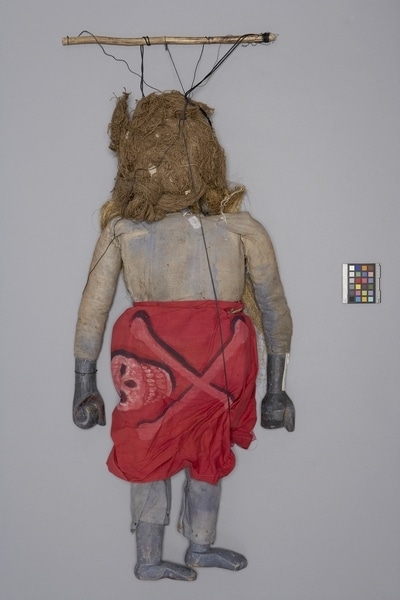String Puppet Item Number: Eh162 a-b from the MOA: University of British Columbia


Description
Three-dimensional male humanoid puppet (Sanni or disease demon dancer character): head with long fibrous hair, moustache and beard (part b) fits into body clothed in a mottled blue and grey shirt and a red and pink knee-length skirt (part a). The body has jointed arms and legs. Figure has a blue-purple face with black painted eyebrows, a red mouth, and bulging, bulbous eyes. Figure has bare blue-purple feet and two blue-purple hands with curled fingers. Puppet is attached to several thin black cords tied to a plain wooden stick.
History Of Use
Lifelike in appearance, the striking rukada (string puppets) of Sri Lanka perform stories about ritual practices and everyday life. There is no scripted play, the puppeteers improvise in their storytelling. The characters, in dress, gesture, and action, express social hierarchies and gender roles: the king and the prince; the politician and the village headman; the policeman and the servant boy; and a family of farmers (Farmer, son, wife, daughter). There are also character archetypes such as the sanni (disease) demon dancer, emaciated beggar with elephantiasis, and jesters in colourful costumes who comically announce the beginning and end of the show (from Shadows, Strings & Other Things, 2019).
Item History
- Made in Galle, Sri Lanka during 1950
- Collected during 1983
- Owned by Jason Schoonover before January 31, 1984
- Received from Museum of Anthropology Shop Volunteers (Funding source) and Jason Schoonover (Seller) on January 31, 1984
What
- Name
- String Puppet
- Identification Number
- Eh162 a-b
- Type of Item
- puppet
- Material
- wood, cotton fibre, plant fibre, paper, paint and dye
- Overall
- height 104.0 cm, width 38.0 cm, depth 18.0 cm
Who
- Culture
- Sinhalese
- Previous Owner
- Jason Schoonover
- Received from
- Museum of Anthropology Shop Volunteers (Funding source) and Jason Schoonover (Seller)
Where
- Holding Institution
- MOA: University of British Columbia
- Made in
- Galle, Sri Lanka
When
- Creation Date
- during 1950
- Collection Date
- during 1983
- Ownership Date
- before January 31, 1984
- Acquisition Date
- on January 31, 1984
Other
- Condition
- fair
- Accession Number
- 0943/0020